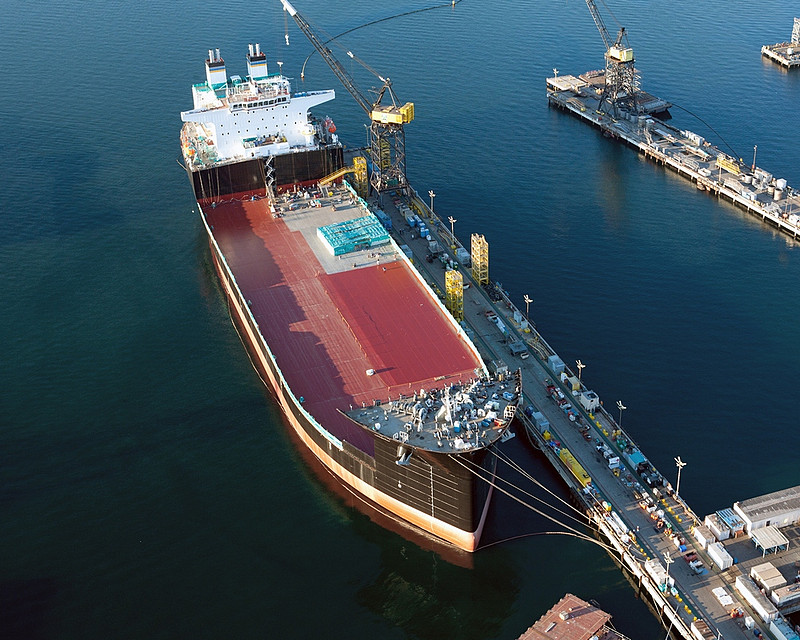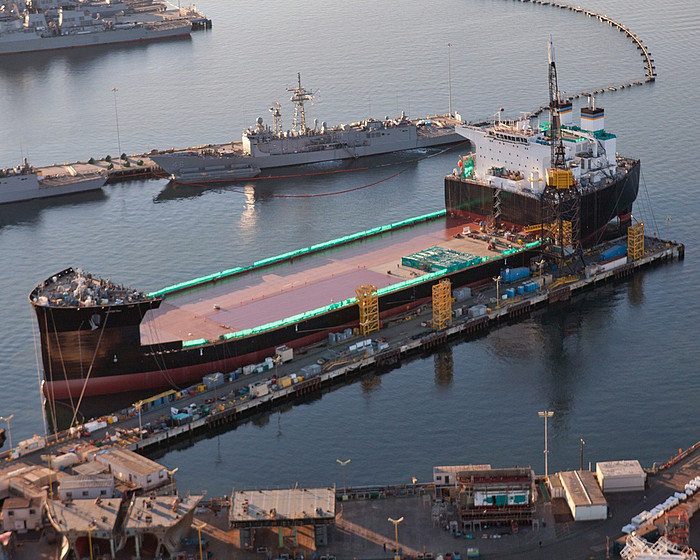ยังงั้นหรือเปล่าครับ
ภาษาอังกฤษผมไม่แข็งแรง
ดูจากรูปเขาคงแปลงให้เปนที่ขึ้นลงสำหรับ ฮ และ บ แนวดิ่ง


Oil Tanker-Turned-Aircraft Carrier Is Key to American Naval Expansion
Giant dock ship can carry jump jets, copters, hovercraft—and for cheap
On Oct. 11 the aircraft carrier Gerald R. Ford, the largest warship ever built—and the most expensive—was floated for the first time at Huntington Ingalls’ shipyard in Newport News, Virginia. The 1,100-foot-long Ford, under construction since 2009 at a cost of $14 billion, boasts a new electromagnetic catapult and facilities for more than 70 warplanes and helicopters, including next-generation drones and stealth fighters still in development.
The sheer awe attending Ford’s progress towards front-line service, slated for 2016, has obscured a less visually impressive but arguably more important milestone for the world’s leading maritime force. On Sept. 15, shipyard workers at General Dynamics’ National Steel and Shipbuilding Company in San Diego floated the John Glenn, the second example of a new but little-known class of dock ship called a “mobile landing platform.”
Few people appreciate it, but the innocuous-looking John Glenn is also a sort of aircraft carrier … in everything but name. But she’s a different kind of carrier than Ford. She’s less specialized and much less heavily armed and armored—and greatly cheaper as a consequence: just $500 million. Her construction, starting in 2012, represents an important trend in the U.S. Navy.
Unheralded by many observers, the sailing branch is buying more copies of less expensive and more flexible vessels like John Glenn, rather than investing solely in the priciest, niche kinds of ships like Ford. The Navy thus has a chance at avoiding the dreaded budgetary “death spiral,” in which more and more money buys less and less hardware, forcing a military branch to shrink into irrelevance.
In that way, the brute-simple John Glenn represents the future of U.S. naval power—even more so than the high-tech starship Ford. Cheaper ships can be more numerous. More numerous ships can maintain a wider presence. “Presence is our mandate,” said Adm. Jonathan Greenert, the Navy’s top officer.



เรือขนส่งน้ำมันกลายร่างเปนเรือบรรทุกเครื่องบิน //////////
ภาษาอังกฤษผมไม่แข็งแรง
ดูจากรูปเขาคงแปลงให้เปนที่ขึ้นลงสำหรับ ฮ และ บ แนวดิ่ง
Oil Tanker-Turned-Aircraft Carrier Is Key to American Naval Expansion
Giant dock ship can carry jump jets, copters, hovercraft—and for cheap
On Oct. 11 the aircraft carrier Gerald R. Ford, the largest warship ever built—and the most expensive—was floated for the first time at Huntington Ingalls’ shipyard in Newport News, Virginia. The 1,100-foot-long Ford, under construction since 2009 at a cost of $14 billion, boasts a new electromagnetic catapult and facilities for more than 70 warplanes and helicopters, including next-generation drones and stealth fighters still in development.
The sheer awe attending Ford’s progress towards front-line service, slated for 2016, has obscured a less visually impressive but arguably more important milestone for the world’s leading maritime force. On Sept. 15, shipyard workers at General Dynamics’ National Steel and Shipbuilding Company in San Diego floated the John Glenn, the second example of a new but little-known class of dock ship called a “mobile landing platform.”
Few people appreciate it, but the innocuous-looking John Glenn is also a sort of aircraft carrier … in everything but name. But she’s a different kind of carrier than Ford. She’s less specialized and much less heavily armed and armored—and greatly cheaper as a consequence: just $500 million. Her construction, starting in 2012, represents an important trend in the U.S. Navy.
Unheralded by many observers, the sailing branch is buying more copies of less expensive and more flexible vessels like John Glenn, rather than investing solely in the priciest, niche kinds of ships like Ford. The Navy thus has a chance at avoiding the dreaded budgetary “death spiral,” in which more and more money buys less and less hardware, forcing a military branch to shrink into irrelevance.
In that way, the brute-simple John Glenn represents the future of U.S. naval power—even more so than the high-tech starship Ford. Cheaper ships can be more numerous. More numerous ships can maintain a wider presence. “Presence is our mandate,” said Adm. Jonathan Greenert, the Navy’s top officer.